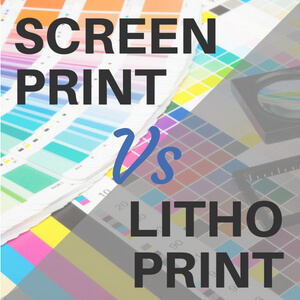Grow Your Brand with Top-Quality litho printing
Grow Your Brand with Top-Quality litho printing
Blog Article
A Comprehensive Overview to Recognizing Litho Printing Strategies
The world of litho printing, a strategy originating from the late 18th century, is a fascinating blend of background, art, advancement and science. This thorough guide will certainly unwind the complexities of this printing approach, from the composition of litho inks to the obstacles dealt with in contemporary applications. As we venture into the ins and outs of lithography, the value of automation and sustainability in ensuring its future importance becomes increasingly clear. Stick with us as we trip right into the captivating realm of litho printing.
The Historical Development of Litho Printing
The historic trajectory of litho printing, an essential technology in the world of interaction, is a fascinating tale of human resourcefulness. The process developed with the arrival of the rotary press, which substantially boosted performance. Each phase of litho printing's evolution showcases humankind's relentless pursuit of performance and quality in aesthetic communication.
Decoding the Science Behind Litho Printing Inks
Progressing in the exploration of litho printing strategies, the focus currently moves to the science behind litho printing inks. The structure of these inks, their drying out procedure, and shade mixing strategies develop the foundation of this intricate art type. Recognizing these elements is essential to mastering the craft and achieving the preferred print results.
Structure of Litho Inks
In lithographic printing, the basic role of litho inks can not be overemphasized. Pigments, the color-providing components, are carefully ground fragments suspended in the vehicle, a liquid that lugs the pigment onto the printing surface. Each element plays a vital component in the last print's quality, making the exact formula of litho inks a detailed science.
Ink Drying Refine
From the composition of litho inks, interest transforms to the interesting process of ink drying. Two key approaches are made use of in litho printing: oxidative drying and absorption. Absorption, on the various other hand, entails the ink leaking into the paper fibers, which is a faster process yet can lead to much less lively colors.
Color Combining Strategies
While the drying out procedure plays an essential function in litho printing, the scientific research of color mixing techniques holds equivalent relevance. This is a complex process that includes the careful blending of key colors: cyan, magenta, and yellow, in differing percentages to achieve a vast variety of tones. The addition of black ink, called 'essential', helps in regulating the strength and depth of the colors. The science behind litho printing inks likewise takes into consideration the transparency of the ink, which influences just how colors overlay and mix. To attain a reliable color mix, print professionals should additionally comprehend the ins and outs of ink habits, shade concept, and the physical properties of the substratum on which the ink is applied.
The Art and Design Elements in Litho Printing
Litho printing breathes life into art and style with its distinct elements. The process includes developing a photo on a lithographic sedimentary rock plate or steel plate with a smooth surface. The picture is then printed onto a tool, generally paper, by moving the ink from home plate. What collections litho publishing apart is its capacity to reproduce intricate layouts with high integrity, making the result nearly the same to the initial artwork. This is attained via the usage of various line techniques such as cross-hatching, stippling, and hatching, which permit for a variety of tonal impacts. Litho printing look at more info fits a range of colors, allowing musicians to develop dynamic and lively prints. This mix of accuracy and versatility makes litho printing a recommended option for several artists and developers.
Modern Applications of Litho Printing Methods
Litho printing strategies have located extensive usage in the modern commercial market. Its impact and importance remain to expand with the development of new developments and modern technologies in the field. This area will certainly explore these modern applications and the transformative function they play in the printing sector.
Industrial Litho Printing Uses
In today's electronic age, one may question the importance of conventional printing methods. Yet, litho printing stays a crucial part of the industrial industry. High-volume printing tasks, such as the manufacturing of publications, newspapers, and packaging, rely upon litho printing for its capability to supply exceptional picture top quality and price effectiveness. The procedure, which includes moving a tattooed image from a plate onto a rubber covering and then to the printing surface, provides unparalleled uniformity. This makes it suitable for jobs requiring a large print run. Litho printing also gives a broad shade spectrum, premium to that of digital printing. This makes it the go-to selection for tasks that demand vibrant, top notch shade recreation.
Technologies in Litho Printing
Pushing the boundaries of standard methods, contemporary improvements have fueled a host of developments in litho printing. One popular development is electronic litho printing, which integrates the merits of electronic modern technology with litho's top notch result. These innovations underscore the long-lasting importance of litho printing in the modern world.
Discovering the Refine of Litho Printing: Detailed

Obstacles and Solutions in Contemporary Litho Printing

Despite the precision and tradition that litho printing happily maintains, it is not without its set of contemporary challenges. The most widespread problems consist of the high initial setup expense, problem in printing variable data, and ecological concerns as a Read More Here result of chemical usage. Remedies are emerging as modern technology advances. Digital litho printing enables cost-effective brief runs and simple modification, dealing with the concern of variable information. Environmentally-friendly inks and more secure plate-making processes minimize environmental worries. In addition, innovations in automation have actually minimized labor costs, even more equalizing the lithography process. Thus, while there are challenges, the litho printing sector is proactively click for more adapting to satisfy them head-on, ensuring its significance in the future.
Verdict
Finally, litho printing, with its abundant background and clinical intricacies, holds a considerable place in the print sector. As the guide reveals, it's a synthesis of art and technology, with modern advancements ensuring its importance. The market encounters challenges that require cutting-edge solutions, with an emphasis on automation and sustainability. The future of litho printing pivots on its capability to adjust to these transforming demands, verifying its enduring value in a progressing market.

Report this page